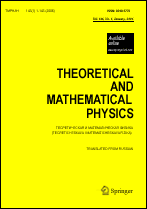|
This article is cited in 21 scientific papers (total in 21 papers)
Formation time of quark–gluon plasma in heavy-ion collisions in the holographic shock wave model
I. Ya. Aref'eva
Steklov Mathematical Institute of Russian Academy of Sciences, Moscow, Russia
Abstract:
We estimate the thermalization time in a holographic model of two colliding shock waves corresponding to heavy-ion collisions. For this, we model the process by the Vaidya metric with a horizon defined by the trapped surface location. We consider two bottom-up AdS/QCD models that in the colliding shock wave approach give a dependence of the multiplicity on energy compatible with the RHIC and LHC results. One model is a bottom-up AdS/QCD confining model, and the other is related to an anisotropic thermalization. We estimate the thermalization time and show that increasing the confining potential decreases the thermalization time and anisotropy accelerates the thermalization.
Keywords:
quark–gluon plasma, heavy-ion collision, thermalization, AdS/QCD correspondence, holography, Lifshitz-like metric.
Received: 18.03.2015
Citation:
I. Ya. Aref'eva, “Formation time of quark–gluon plasma in heavy-ion collisions in the holographic shock wave model”, TMF, 184:3 (2015), 398–417; Theoret. and Math. Phys., 184:3 (2015), 1239–1255
Linking options:
https://www.mathnet.ru/eng/tmf8936https://doi.org/10.4213/tmf8936 https://www.mathnet.ru/eng/tmf/v184/i3/p398
|


| Statistics & downloads: |
| Abstract page: | 545 | | Full-text PDF : | 174 | | References: | 58 | | First page: | 15 |
|




 Contact us:
Contact us: Terms of Use
Terms of Use
 Registration to the website
Registration to the website Logotypes
Logotypes








 Citation in format
Citation in format 
